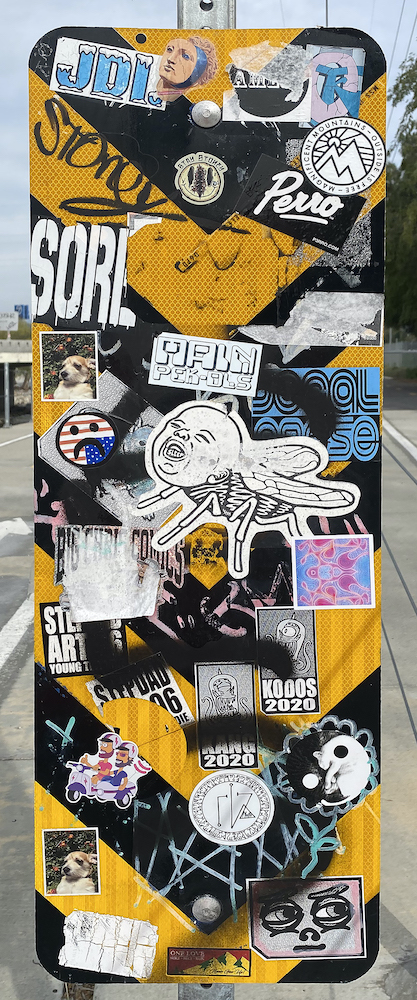Graffiti has always been a declaration of independence and individuality; it’s the big I AM, designed to disrupt everyone else. Large Graf throw-ups, or wall pieces, may show off the artist’s skill and message, but they are also considered vandalism—incurring maximum reaction from the police. “Fellons,” specific street painters considered the most infamous, face incarceration and steep fines if caught, so they often resort to stickering instead. Stickering, also known as sticker-bombing, slap-tagging and sticker-slapping, is the act of attaching stickers to surfaces where they will get the most attention. Stickers are considered as much of a civic nuisance as murals but result in virtually no prosecutions. San Francisco stickerer Justin Kerson explained in an email, “Stickering falls inside a gray area when the defense is worded right. If a cop asks, I tell them it’s a temporary, removable political campaign protected by an amendment. And it’s not just the cops that go easy on stickers, I’m buddies with so many different Graf crews because I don’t paint and my stickering is not a threat to them.”
Another advantage of stickers is that, if slapped in the right place, they remain in situ far longer than a wall that took hours to paint. Plus, a sticker may burn on a sign and be seen by just as many people as a large piece. Most importantly—although wall murals may be the most impressive form of Graf—they require an audience that comes to them. Stickers are free of this constraint: When applied to a kid’s water bottle, guitar or laptop, they get mobile city-wide exposure. This populist approach can result in a tight camaraderie. Kerson maintained, “If a homie asks for a stack heading out of town, you give it to them. So, I get pics of stickers I never put up all the time. I figure I have over 100,000 stickers running across the world; Earth is small these days.”
This earthly diminution can be attributed to the web and a youth culture that embraces instantaneous global communication. More importantly, it has resulted in an informal international sticker exchange. Stickers are sent from one country to another, and the satisfaction Kerson gets from seeing his stickers in Africa is equal to a foreign stickerer’s thrill at receiving photos of theirs in California. Even so, there are people who bypass that reciprocity, said Kerson. “You can pay other people to wheatpaste or put up your stickers, but it’s still your idea.”
Stickers can represent that a person has gone there, to another place; but to the street-initiated, they also signify a person has been here, in the same place. Sticker-bombing, like tagging, is a quick way to claim territory, but it’s an equally efficient way to invade. In the end, Kerson admitted, “It’s still the ego, dog-pee-on-everything game.”


